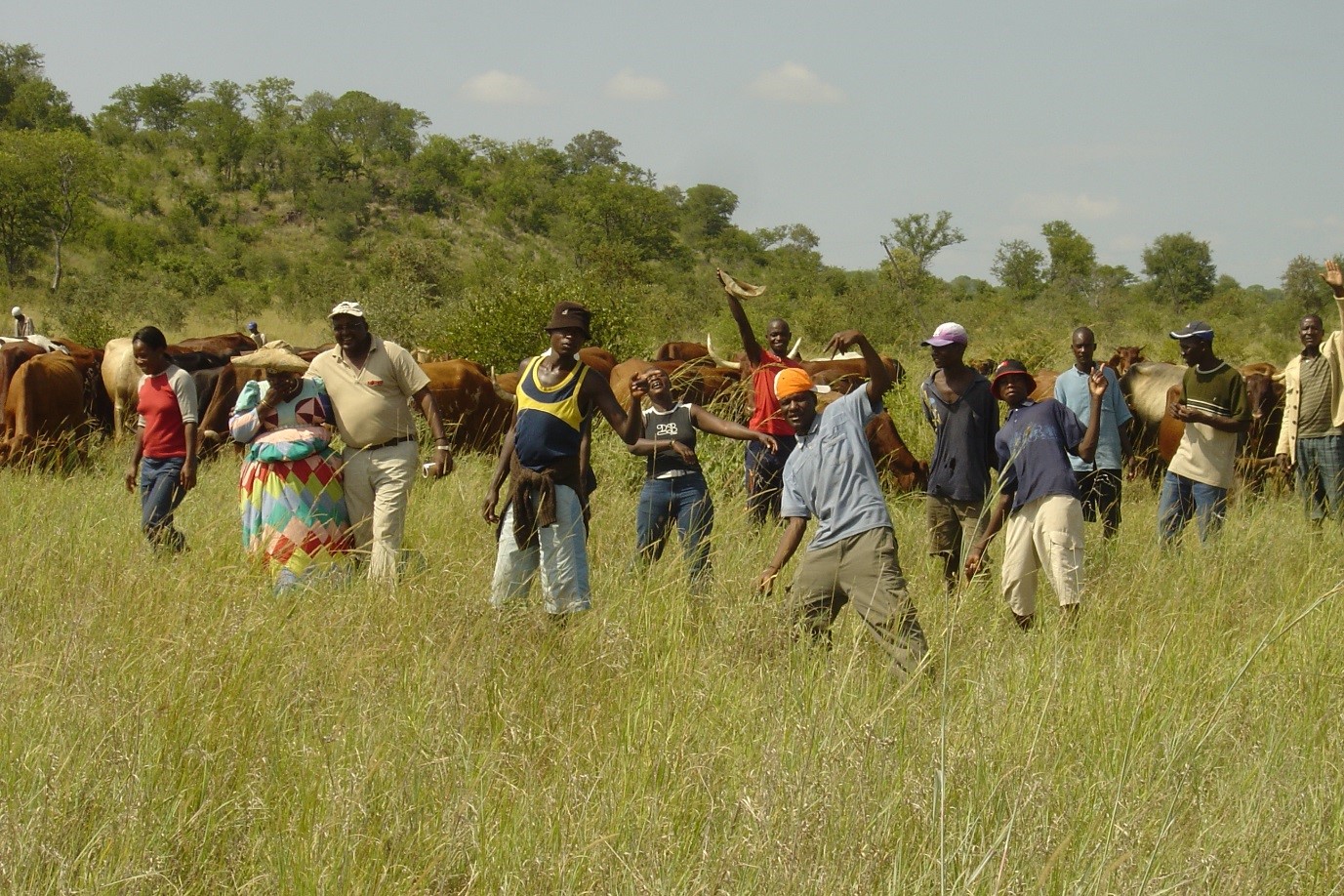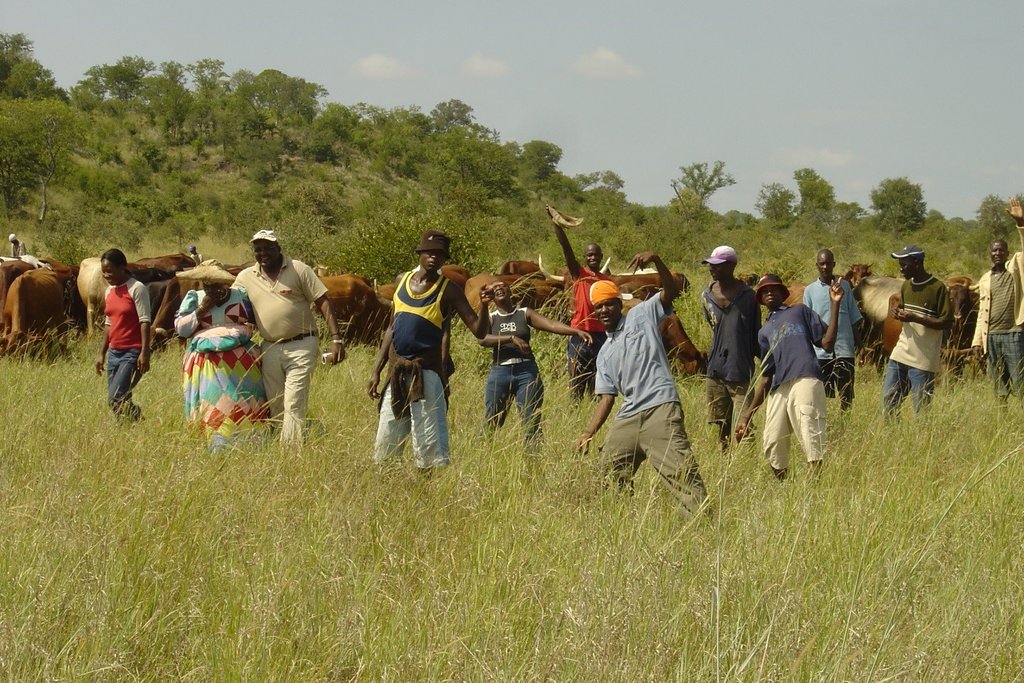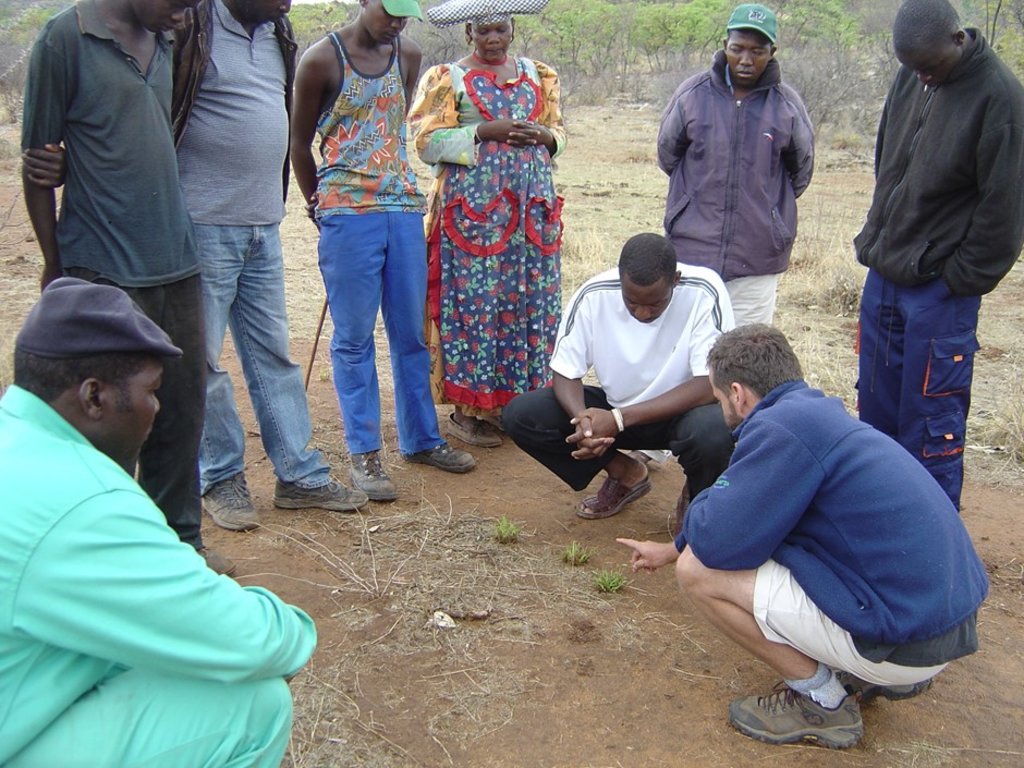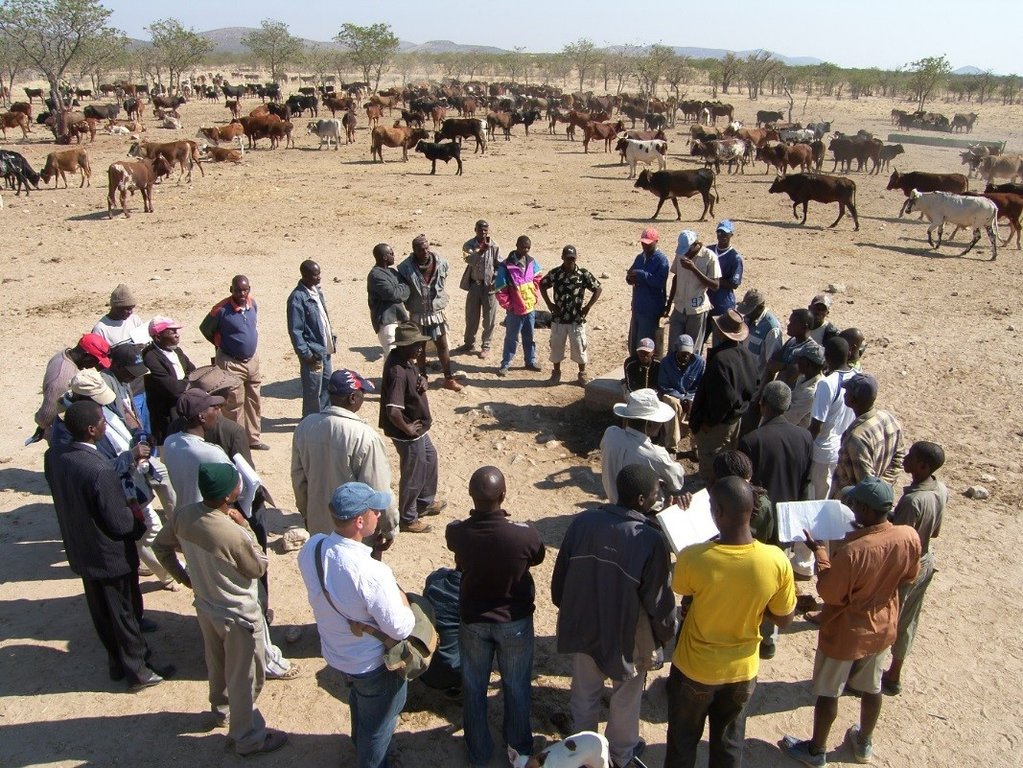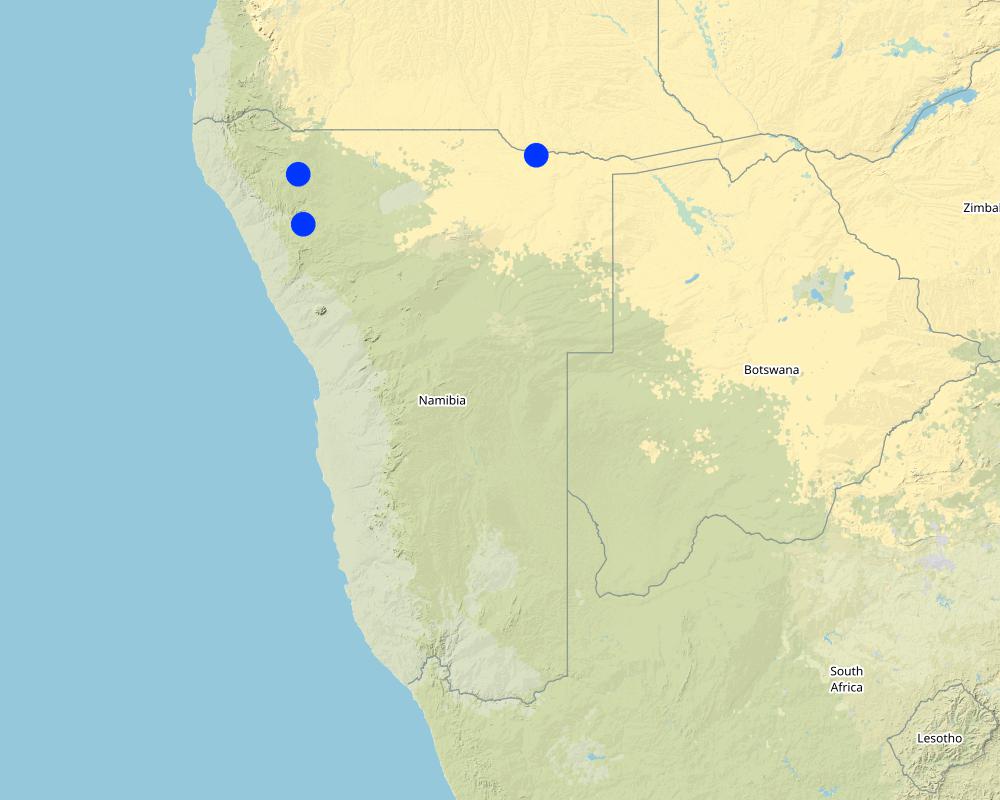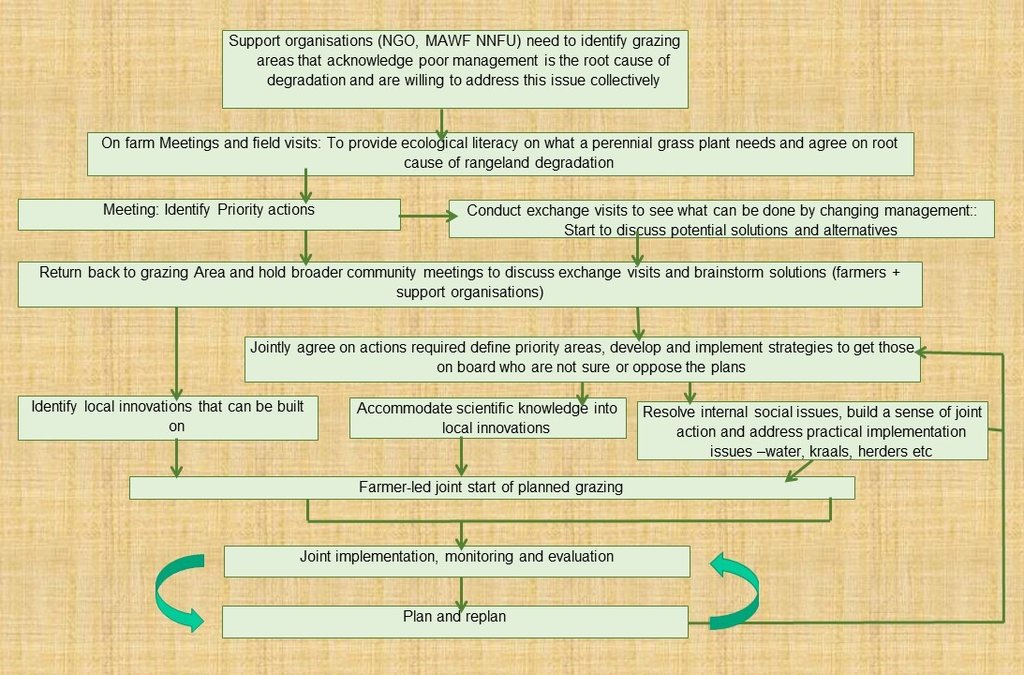Community grazing management [Намиби]
- Шинийг нээх:
- Шинэчлэх:
- Эмхэтгэгч: Ibo Zimmermann
- Хянан тохиолдуулагч: –
- Хянагчид: Rima Mekdaschi Studer, Joana Eichenberger
Omarisiro wovinamuinjo motjimbumba
approaches_3050 - Намиби
Бүлгүүдийг үзэх
Бүгдийг дэлгэх Бүгдийг хаах1. Ерөнхий мэдээлэл
1.2 Арга барилыг баримтжуулах болон үнэлгээ хийхэд оролцсон хүн эсвэл байгууллагын холбоо барих хаяг
Газар ашиглагч:
Арга барилыг баримтжуулах/үнэлэх ажилд дэмжлэг үзүүлсэн төслийн нэр (шаардлагатай бол)
Southern African Science Service Centre for climate change and Adaptive Land management (SASSCAL)Арга барилыг баримтжуулах/үнэлэх ажилд дэмжлэг үзүүлсэн төслийн нэр (шаардлагатай бол)
Book project: Guidelines to Rangeland Management in Sub-Saharan Africa (Rangeland Management)Арга барилыг баримтжуулах/үнэлэх ажилд дэмжлэг үзүүлсэн байгууллага(ууд)-ын нэр (шаардлагатай бол)
Conservation Agriculture Namibia (Conservation Agriculture Namibia) - НамибиАрга барилыг баримтжуулах/үнэлэх ажилд дэмжлэг үзүүлсэн байгууллага(ууд)-ын нэр (шаардлагатай бол)
Zakumuka Producers Co-operative (Zakumuka Producers Co-operative) - Намиби1.3 WOCAT-аар баримтжуулсан өгөгдлийг ашиглахтай холбоотой нөхцөл
Мэдээллийг хэзээ (газар дээр нь) цуглуулсан бэ?
2017
Эмхэтгэгч болон гол мэдээлэгч хүн(хүмүүс) WOCAT аргачлалаар баримтжуулсан мэдээллийг ашиглахтай холбоотой нөхцлийг хүлээн зөвшөөрсөн:
Тийм
1.4 ГТМ-ийн технологийн асуулгын(д) суурь мэдээлэл(д)
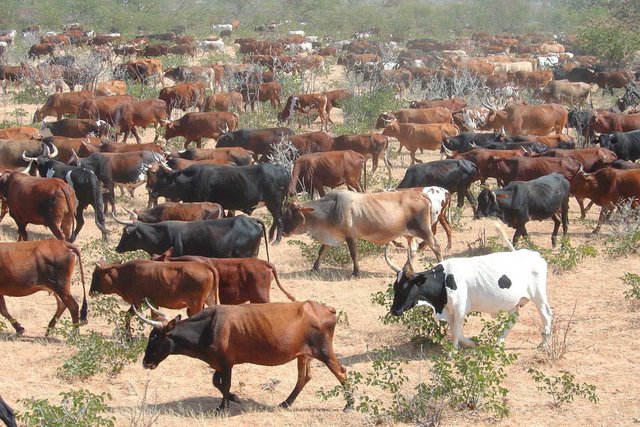
Combined herding for planned grazing [Намиби]
Daily combining of livestock from all households into a single herd to be driven to different designated portions of the communal grazing area. Grass can then recover by replenishing its reserves before being re-grazed some months later.
- Эмхэтгэгч: Ibo Zimmermann
2. ГТМ Арга барилын тодорхойлолт
2.1 Арга барилын товч тодорхойлолт
Agreement among community members to jointly manage their communal grazing area by combining their livestock into a single herd. The herd is managed and moved according to an agreed growing season plan that provides sufficient recovery for perennial grasses, and a non-growing season plan to graze in a way that prepares soil and plants for the next season. Regenerating rangeland productivity and well-being is the goal.
2.2 Арга барилын дэлгэрэнгүй тодорхойлолт
Арга барилын дэлгэрэнгүй тодорхойлолт:
The approach is a partnership between an NGO, Ministry of Land Reform (MLR), Ministry of Agriculture , Water and Forestry (MAWF), the National Farmers Union (NNFU), traditional authorities, and regional and local government. The NGO raises awareness among the community about the damage caused to the rangeland by individual herds of livestock grazing continuously – and to appreciate the benefits of planned grazing. Livestock owners invite facilitators to compare the current state of their land with that of the past. The reasons for the decline are investigated. Once livestock owners understand that perennial grasses need recovery, they soon conclude that their management caused the loss of perennial grass and the increase in bare ground. At this point, the aim of the approach can be pursued. This is to regenerate rangeland productivity in the communal grazing area and thereby support higher livestock production. This in turn supports livelihoods.
If motivation to apply planned grazing exists among the community members, then their right to claim common property ownership needs to be established. In pioneering communities this requires at least 10 village level livestock owner meetings to decide on modalities of planned grazing. These meetings continue after planned grazing has started to deal with ongoing planning, animal production and marketing. Exposure visits to areas with successful grazing management help. On return frequent follow-up meetings, facilitated by the NGO and the MAWF, can resolve local issues, including traditional taboos, such as combining animals in one kraal, and whose bulls should be kept and managed.
Boundaries with neighbouring communities need to be mapped, recognised and respected by all. In case of grass poaching, the offenders must to be swiftly dealt with, preferably through customary law. A grazing plan needs to be agreed by all livestock owners, and endorsed by the local Traditional Authority. The grazing area (GA) is then mapped, while six herders, one of whom is their manager, are appointed from among the community though common agreement. Each livestock owner pays a portion of the herding and management cost pro-rata based on the number of his livestock. At night the cattle are separated and kraaled near the homesteads of their owners. In the morning, the herders collect cattle from the kraals. Different portions of the grazing area are grazed daily and only returned to when the grass has replenished its root reserves - some months later.
The process started at Erora in 2004, facilitated by the NGO, Integrated Rural Development and Nature Conservation (IRDNC). Implementation began in 2006, combining approximately 1200 cattle from 12 households. Livestock owners noticed a higher density of annual grasses after the first season; dramatic improvement in soil cover after three years with emergence of grass seedlings where none had grown for decades. Then after another three years, perennial grasses returned with increased biodiversity in many parts. However, when the extended drought started in 2011, planned grazing was interrupted and gullies expanded, down which rainwater flowed, dehydrating the rangelands. The drought lasted for five years, and the planned grazing was temporarily discontinued in 2013. During this period, rehabilitation work included constructing bush filters along key gullies: facilitation was taken over by another NGO, Conservation Agriculture Namibia (CAN). After successive years of severe drought, cattle became too weak to be rounded up, and in 2014 the community members decided to revert to keeping cattle near their homesteads. This was intended to be temporary but cattle only gained sufficient strength in 2017. The communal grazing management approach was extended to other villages in 2012, despite the drought. New boreholes were drilled and installed to facilitate improved planned grazing.
2.3 Арга барилын зурагууд
2.4 Арга барилын бичлэгүүд
Тайлбар, товч тодорхойлолт:
www.youtube.com/watch?v=xNyFkDUH6MQ
This video is from a DVD created by the Integrated Rural Development and Nature Conservation (IRDNC), a Namibian NGO and co-sponsored by the Namibian Ministry of Agriculture and the Namibian National Farmers Union. The video documents the development of a rangeland program focused on Holistic Management, spearheaded by Colin Nott, a Holistic Management educator.
Огноо:
2007
Байршил:
Erora, Namibia
Зураглаачийн нэр:
Andrew Botelle
Тайлбар, товч тодорхойлолт:
www.youtube.com/watch?v=3Ey5v40KtkI
Combined herding to manage communal grazing with the use of stress-free handling of cattle,
Огноо:
2007
Байршил:
Erora, Namibia
Зураглаачийн нэр:
Andrew Botelle
Тайлбар, товч тодорхойлолт:
www.youtube.com/watch?v=6C4V_Cib8ts
Managing water flow to repair gully erosion
Огноо:
2015
Байршил:
Namibia
Зураглаачийн нэр:
Andrew Botelle
2.5 Арга барил нэвтрүүлсэн улс орон / бүс нутаг / байршил
Улс:
Намиби
Улс/аймаг/сум:
Kunene Region
Байршлын дэлгэрэнгүй тодорхойлолт:
Erora village, 18.32637 South, 14.05912 East
Map
×2.6 Арга барилыг эхлэх, дуусах огноо
Эхлэх жилийг тэмдэглэ:
2004
Тайлбар:
Combined herding was discontinued at Erora in 2013 due to extreme drought, which ended in 2016/2017 rainy season, and land users are planning to use reserved grazing, whereby cattle are taken out each day by herders and left there to return on their own to water points. In the meantime, combined herding has already resumed at the Outokotorua grazing area.
2.7 Арга барилын төрөл
- Science informs the traditional practice
2.8 Арга барилын үндсэн зорилго, зорилтууд
To regenerate rangeland productivity for supporting livelihoods and improved quality of life.
2.9 Арга барилын хүрээнд хэрэгжсэн Технологи/Технологиудад дэмжсэн эсвэл саад учруулсан нөхцлүүд
нийгэм / соёл / шашны хэм хэмжээ, үнэт зүйлс
- Идэвхижүүлэх
Herding is customary, and the task is now shared among families
- Хазаарлалт
Herding no longer carries the high social status that it had previously.
санхүүгийн нөөц, үйлчилгээний хүртээмж / боломж
- Идэвхижүүлэх
No bought inputs are required, and fewer herders needed than with many small herds. Also fewer losses from stock theft and predators
Бүтэц зохион байгуулалт
- Идэвхижүүлэх
A grazing area committee was established with support of livestock owners
- Хазаарлалт
The grazing area committee is not legally recognised
талуудыг хамтын ажиллагаа/зохицуулалт
- Идэвхижүүлэх
Partnership approach with MLR, Ministry of Agriculture, Water and Forestry (MAWF) the NNFU, traditional authorities and regional and local government.
- Хазаарлалт
Resolution of local issues to apply grazing plans needs to be resolved
Хууль, эрхзүйн хүрээ (газар эзэмшил, газар, ус ашиглах эрх)
- Идэвхижүүлэх
National Policy and strategy is in place which supports sound management principles
- Хазаарлалт
Grass poaching by neighbouring communities is not adequately dealt with by the law
Бодлогууд
- Идэвхижүүлэх
The approach is based upon the Namibia National Rangeland Management Policy and Strategy
- Хазаарлалт
Common property rights are insufficiently promoted
Газрын засаглал (шийдвэр гаргах, хэрэгжүүлэх, шаардлага)
- Хазаарлалт
Lack of integration of different scales of management between conservancies at large scales and grazing areas at smaller scale is required
ГТМ-ийн талаарх мэдлэг, техникийн дэмжлэг авах боломж
- Идэвхижүүлэх
The awareness exists among participating livestock owners and stakeholders
зах зээл (материал худалдан авах, бүтээгдэхүүн борлуулах), үнэ
- Идэвхижүүлэх
The Namibia National Farmers Union is busy addressing markets north of the veterinary cordon fence, which maintains a zone free of foot-and-mouth disease to the south from where farmers are able to access the lucrative EU market
- Хазаарлалт
During drought the drop in prices from sudden increase in supply, results in inability of farmers to sell livestock when sudden shortage of forage occurs
ажлын багтаамж, хүн хүчний нөөц бололцоо
- Идэвхижүүлэх
Fewer herders are required for one large herd than for many small herds
- Хазаарлалт
The role of herders as rangeland managers lacks status and is not adequately appreciated, resulting in high turnover of trained herders and their manager.
Бусад
- Хазаарлалт
One large livestock owner at a given place can hinder efforts of the majority to improve rangeland management
3. Оролцогч талуудын оролцоо ба үүргүүд
3.1 Арга барилд оролцогч талууд болон тэдгээрийн үүргүүд
- Орон нутгийн газар ашиглагч / орон нутгийн иргэд
Communities of Erora, Outokotorua and Nsindi
To organise, plan and implement
- олон нийтэд түшиглэсэн байгууллагууд
Grazing Committee
Oversee day to day implementation
- ГТМ-ийн мэргэжилтэн/ хөдөө аж ахуйн зөвлөх
Integrated Rural Development and Nature Conservation (IRDNC), then Conservation Agriculture Namibia (CAN) and Namibia National Farmers Union (NNFU)
To facilitate adoption and upscaling of the approach
- Судлаачид
United States Department of Agriculture (USDA)
To assess rangeland condition changes
- ТББ
First IRDNC, then CAN
To facilitate the approach
- Хувийн хэвшил
Zakumuka Producers Cooperative
To organise auctions for sale of livestock
- Орон нутгийн захиргаа
Traditional authorities
To support and enable agreed rules
- Засгийн газар (шийдвэр гаргагч, төлөвлөгч)
Namibian Ministries of Lands & Agriculture
Assist with facilitation and support
- Farmers union
Namibia National Farmers Union
Enabling policy and legislation
Хэрэв хэд хэдэн оролцогч талууд оролцсон бол голлох төлөөлөгчийг зааж өгнө үү:
Integrated Rural Development and Nature Conservation (IRDNC), taken over in 2014 by Conservation Agriculture Namibia (CAN)
3.2 Арга барилын янз бүрийн үе шатанд орон нутгийн газар ашиглагчид / бүлэглэлүүдийг татан оролцуулах
| Орон нутгийн газар ашиглагч / орон нутгийн иргэдийн оролцоо | Хэн оролцсоныг тодорхойлж, үйл ажиллагааг тайлбарлана уу | |
|---|---|---|
| санаачлага/идэвхжүүлэлт | интерактив | The community, with focus on livestock owners, youth, women and herders, under facilitation by NGO by conducting exchange visits to neighbouring countries |
| Төлөвлөгөө | интерактив | Feedback was given to communities by participants of exchange visits, grazing committees appointed to contextualise and re-plan for the way forward under guidance of NGO, Ministry of Agriculture, Water and Forestry (MAWF) and Namibia National Farmers Union (NNFU) |
| Хэрэгжилт | интерактив | The grazing committee, livestock owners and herders carry out the grazing plan with support of NGO, MAWF and NNFU |
| Мониторинг/ үнэлгээ | интерактив | The grazing committee and livestock owners constantly plan and replan and evaluate results on livestock performance and rangeland and daily check where livestock have grazed and where they will graze next and feed results into re-planning. Annual assessments of forage in May, to determine stocking rate. |
| external assessment of data | Гадаад дэмжлэг | External assessment by researchers of data gathered by USDA through Innovations for Poverty Action (IPA) |
3.3 Диаграм (хэрэв боломжтой бол)
Тодорхойлолт:
Flow chart of the process to facilitate community grazing management.
Зохиогч:
Colin Nott
3.4 ГТМ-ийн технологи/технологиуд сонгох шийдвэр
Хэрэгжүүлэх Технологи/Технологиудын сонголтыг хийж шийдвэр гаргасан хүнийг тодорхойлно уу:
- ГТМ-ийн мэргэжилтнүүдийн дэмжлэгтэйгээр, голчлон газар ашиглагчид
Тайлбар:
After exposure to sound management techniques and on farm identification and agreement on the root cause of the degradation – the farmers themselves decide if they will continue or not.
Шийдвэрийг юунд үндэслэн гаргасан:
- ГТМ-ийн мэдлэгийг баримтжуулалтын үнэлгээ (нотолгоонд суурилсан шийдвэр гаргах)
- Хувь хүний туршлага ба санал бодол (баримтжуулаагүй)
4. Техникийн дэмжлэг, чадавхи бүрдүүлэх, мэдлэгийн менежмент
4.1 Чадавхи бэхжүүлэх/сургалт
Газар эзэмшигчид / бусад оролцогч талуудад сургалт явуулсан уу?
Тийм
Хэн сургалтанд хамрагдсан бэ:
- Газар ашиглагчид
- хээрийн ажилтан / зөвлөх
- Ministry of Agriculture, Namibia National Farmers Union.
Хэрэв шаардлагатай бол хүйс, нас, яс үндэс, гэх мэт. нэмнэ үү:
Inclusion of youth, women and herders.
Сургалтын хэлбэр:
- Ажил дээр
- фермерээс -фермер
- Олон нийтийн уулзалт
Хамрагдсан сэвдүүд:
On farm(s) exploration of root cause of degradation based on how it was in the past and how it looks now and why this change has happened.
Тайлбар:
A number of issues including: Rangeland management, focussing on the needs of grass plants and soil. Needs of herders, people and stakeholders and how these various needs can be met. Institutional support for grazing committee, focussing on budgeting and financial management.
4.2 Зөвлөх үйлчилгээ
Газар ашиглагчдад зөвлөх үйлчилгээ авах боломжтой байдаг уу?
Тийм
Зөвлөх үйлчилгээ үзүүлсэн эсэхийг тогтоо:
- Газар ашиглагчийн талбай дээр
- Visits to successful farmers
Тодорхойлолт / тайлбар:
Mostly through exchange visits, community meetings, on farm excursions and on-the-job training.
4.3 Институцийг бэхжүүлэх (байгууллагын хөгжил)
Арга барилаар дамжуулан институц байгуулагдаж эсвэл бэхжсэн үү?
- Тийм, маш их
Байгууллагууд бэхжиж, үүсэн бий болсон түвшин(үүд)-г тодорхойлно уу:
- Орон нутгийн
- Бүс нутгийн
Байгууллага, үүрэг, хариуцлага, гишүүд гэх мэтийг тайлбарлах:
Grazing Committee guides and implements the grazing plans and support organisations including Ministry of Agriculture, Namibia National Farmers Union and NGOs provide support and advice.
Дэмжлэгийн төрлийг ялга:
- чадавхи бэхжүүлэх / сургалт
- Тоног төхөөрөмж
Дэлгэрэнгүй мэдээллийг өгнө үү:
Exchange visits, facilitation of meetings and on-the-job training. Drilling and equipping of boreholes. Redesign of water supply for livestock and combined kraaling system.
4.4 Мониторинг ба үнэлгээ
Мониторинг болон үнэлгээ нь арга барилын хэсэг үү?
Тийм
Тайлбар:
To support decision making
Хэрэв тийм бол энэ баримт бичиг нь мониторинг, үнэлгээнд ашиглагдахаар зориулагдсан уу?
Үгүй
4.5 Судалгаа
Судалгаа арга барилын хэсэг нь байсан уу?
Тийм
Сэдвийг тодруулна уу:
- Социологи
- Эдийн засаг/ зах зээл
- Экологи
Дэлгэрэнгүй мэдээллийг өгч, хэн судалгаа явуулсныг бичнэ үү:
USDA/IPA came to evaluate rangelands and consult key stakeholders
5. Санхүүгийн болон гадаад материаллаг дэмжлэг
5.1 ГТМ-ийн Арга барилын бүрэлдэхүүн хэсгийн жилийн төсөв
Арга барил дахь ГТМ-ийн бүрэлдэхүүн хэсгийн жилийн төсвийг ам.доллараар харуулна уу:
10000.00
Хэрэв жилийн төсөв тодорхойгүй бол хягаарыг тодруулна уу:
- 10,000-100,000
Тайлбар (жнь: санхүүжилтийн гол эх үүсвэр / гол хандивлагчид):
Major donor to initiate the project was Enagelica Entwikelins Diens (EED), through IRDNC and later funding came from the Millenium Challenge Account (MCA), the EU and now the Finnish Embassy through CAN. Cost is per grazing area for local level field facilitation.
5.2 Газар ашиглагчдад санхүүгийн / материаллаг дэмжлэг үзүүлсэн
Технологи / технологийг хэрэгжүүлэхэд газар ашиглагчид санхүүгийн / материаллаг дэмжлэг авсан уу?
Тийм
Хэрэв тийм бол дэмжлэгийн төрөл(үүд), нөхцөл, болон нийлүүлэгч(чид) бичнэ үү:
Upgrades of boreholes, drilling and equipping of new boreholes that are elephant-proof and construction of lion-proof kraaling was funded through the NGO.
5.3 Тодорхой зардлыг даахад чиглэсэн дэмжлэгт (хөдөлмөрийн хүчийг оролцуулаад)
- Ажил хөдөлмөр
| Ямар талбайн хэмжээнд | Тэтгэмж, урамшууллыг тодорхойлно уу |
|---|---|
| хэсэгчлэн санхүүждэг | Part payment to herders 2004-2007 in Erora only |
- бусад
| Бусад (тодорхойлно уу) | Ямар талбайн хэмжээнд | Тэтгэмж, урамшууллыг тодорхойлно уу |
|---|---|---|
| Boreholes and kraals | хэсэгчлэн санхүүждэг | Erora upgrade USD 10 000, second solar borehole half funded by community USD 10 000. Lion proof kraal funded by Africat – USD 2 000 |
Хэрэв газар ашиглагчийн хөдөлмөрийн хүч чухал байсан бол энэ нь аль хэлбэр байсан:
- бэлэн мөнгөөр төлдөг
Тайлбар:
Only for first four years at one of the villages to enable proof of concept to be established.
5.4 Кредит
Арга барилын хүрээнд ГТМ-ийн үйл ажиллагаанд зориулж зээлд хамрагдсан уу?
Үгүй
5.5 Бусад урамшуулал, хэрэгсэл
ГТМ-ийн технологийг хэрэгжилтийг дэмжихэд ашигласан бусад урамшуулал, хэрэгсэл байсан уу?
Үгүй
6. Нөлөөллийн дүн шинжилгээ ба дүгнэлт
6.1 Арга барилын нөлөөллүүд
Арга барил нь орон нутгийн газар ашиглагчдыг чадваржуулах, оролцогч талуудын оролцоог сайжруулсан уу?
- Үгүй
- Тийм, бага зэрэг
- Тийм, зарим
- Тийм, их
Through the whole approach.
Арга барил нь нотолгоонд суурилсан шийдвэр гаргах боломж олгосон уу?
- Үгүй
- Тийм, бага зэрэг
- Тийм, зарим
- Тийм, их
Through observations by herders and livestock owners.
Арга барил нь ГТМ-ийн технологийг хэрэгжүүлж, хадгалахад газар ашиглагчдад тусласан уу?
- Үгүй
- Тийм, бага зэрэг
- Тийм, зарим
- Тийм, их
Combined herding through planned grazing.
Арга барил нь ГТМ-ийн зардал хэмнэсэн хэрэгжилт, зохицуулалтыг сайжруулсан уу?
- Үгүй
- Тийм, бага зэрэг
- Тийм, зарим
- Тийм, их
Key stakeholders are all involved.
Арга барил нь ГТМ-ийн хэрэгжилтийн санхүүгийн эх үүсвэрийн хүртээмжийг сайжруулах / эргэлтэнд оруулахад чиглэсэн үү?
- Үгүй
- Тийм, бага зэрэг
- Тийм, зарим
- Тийм, их
Арга барил нь ГТМ хэрэгжүүлэхэд газар ашиглагчдын мэдлэг, чадварыг сайжруулахад хүргэсэн үү?
- Үгүй
- Тийм, бага зэрэг
- Тийм, зарим
- Тийм, их
Training provided the skills to self organise and implement activities based upon identification of root cause of land degradation.
Энэ арга барил бусад сонирхогч талуудын мэдлэг, чадавхийг сайжруулсан уу?
- Үгүй
- Тийм, бага зэрэг
- Тийм, зарим
- Тийм, их
Ministries of Agriculture and Lands.
Арга барил нь оролцогч талуудын хооронд институци, хамтын ажиллагааг бий болгож, бэхжүүлсэн үү?
- Үгүй
- Тийм, бага зэрэг
- Тийм, зарим
- Тийм, их
Key stakeholders are all collaborating, since the solution to rangelands cuts across various sectors.
Энэ арга барил зөрчилдөөнийг багасгасан уу?
- Үгүй
- Тийм, бага зэрэг
- Тийм, зарим
- Тийм, их
Reinstated sense of community
Арга барил нь эмзэг бүлгийнхнийг нийгэм, эдийн засгийн хувьд чадавхижуулсан уу?
- Үгүй
- Тийм, бага зэрэг
- Тийм, зарим
- Тийм, их
Women-headed households now have their livestock herded communally.
Арга барил нь жендэрийн тэгш байдлыг сайжруулж, эмэгтэйчүүд, охидыг чадавхжуулсан уу?
- Үгүй
- Тийм, бага зэрэг
- Тийм, зарим
- Тийм, их
Women-headed households now have their livestock herded communally.
Арга барил нь газар ашиглагч залуучууд / дараагийн үеийн хүмүүсийг ГТМ-д оролцохыг хөхүүлэн дэмжсэн үү?
- Үгүй
- Тийм, бага зэрэг
- Тийм, зарим
- Тийм, их
Herders are mainly youth and young livestock owners, who appreciate improved rangeland and are now willing to remain.
Арга барил нь ГТМ-ийн технологийг хэрэгжүүлэхэд саад учруулсан газрын эзэмшил / ашиглах эрхийг сайжруулахад чиглэсэн үү?
- Үгүй
- Тийм, бага зэрэг
- Тийм, зарим
- Тийм, их
The willingness to address appropriate land rights may initiate resolution of land issues.
Арга барил нь чанаржуулсан шим тэжээл/ хүнсний аюулгүй байдалд хүргэсэн үү?
- Үгүй
- Тийм, бага зэрэг
- Тийм, зарим
- Тийм, их
Much during good rains and little during drought.
Арга барил нь зах зээлийн хүртээмжийг сайжруулсан уу?
- Үгүй
- Тийм, бага зэрэг
- Тийм, зарим
- Тийм, их
Арга барил нь ус, ариун цэврийн байгууламжийн хүртээмжийг сайжруулахад хүргэсэн үү?
- Үгүй
- Тийм, бага зэрэг
- Тийм, зарим
- Тийм, их
Access to borehole water was provided.
Арга барил нь эрчим хүчний эх үүсвэр/ илүү тогтвортой ашиглалтад хүргэх үү?
- Үгүй
- Тийм, бага зэрэг
- Тийм, зарим
- Тийм, их
Solar installations were installed or replaced diesel where possible for pumping of water.
Арга барил нь газар ашиглагчид уур амьсгалын өөрчлөлтөд дасан зохицох чадварыг дээшлүүлж, уур амьсгалын өөрчлөлттэй холбоотой гамшгийг бууруулах чадавхийг сайжруулсан уу?
- Үгүй
- Тийм, бага зэрэг
- Тийм, зарим
- Тийм, их
Improved grass growth in good rain years and improved survival in drought.
Арга барил нь хөдөлмөр эрхлэлт, орлогын боломжид хүргэсэн үү?
- Үгүй
- Тийм, бага зэрэг
- Тийм, зарим
- Тийм, их
Herders and managers were appointed.
6.2 ГТМ-ийг хэрэгжүүлэх газар ашиглагчидын гол санаачилга
- үйлдвэрлэл нэмэгдсэн
Increased grass, higher calving and reduced mortalities.
- Ашиг нэмэгдсэн (боломж), зардал-үр ашгийн харьцаа сайжирсан
Increased grass, higher calving and reduced mortalities.
- Газрын доройтол буурсан
Changing unsustainable practices for improved resource base.
- Ажлын ачаалал бууруулсан
Fewer herders needed.
- нэр хүнд, нийгмийн дарамт / нийгмийн холбоо
Social cohesion to implement joint management.
- Байгаль орчны ухамсар
To support the future of livestock in their area.
6.3 Арга барилын үйл ажиллагааны тогтвортой байдал
Газар ашиглагчид арга барилаар дамжуулан хэрэгжүүлсэн арга хэмжээг тогтвортой хадгалж чадах уу (гадны дэмжлэггүйгээр)?
- Тийм
Хэрэв тийм бол яаж гэдгийг тайлбарлана уу:
They mobilise themselves, appoint herders, do the implementation, do the planning jointly and, and only asking for some technical support.
6.4 Арга барилын тогтвортой/давуу тал/боломжууд
| Газар ашиглагчдын тодорхойлсон давуу тал/боломжууд |
|---|
| By caring for the rangeland, farmers will have grass all year round and minimise effects of drought. |
| Эмхэтгэгч, бусад мэдээлэл өгсөн хүмүүсийн өнцгөөс тодорхойлсон давуу тал/боломжууд |
|---|
| It has proven to improve the resource base if applied properly. |
| It is viable and upscalable. |
| It has diverse benefits for the land user, including economic, social and environmental. |
6.5 Арга барилын дутагдалтай/сул тал/аюул болон тэдгээрийн хэрхэн даван туулах арга замууд
| Газар ашиглагч нарын тодорхойлсон сул тал/ дутагдал/ эрсдэл | Тэдгээрийг хэрхэн даван туулах вэ? |
|---|---|
| If a new water point needs to be developed, then funds will be required | Convince land users that by selling one or a few cattle to invest in a new water point, they will realise the returns from increased productivity within a few years. |
| Эмхэтгэгч, бусад мэдээлэл өгсөн хүмүүсийн өнцгөөс тодорхойлсон сул тал/ дутагдал/ эрсдэл | Тэдгээрийг хэрхэн даван туулах вэ? |
|---|---|
| The herding is hard work, the status of herders is perceived to be low and they are poorly compensated. |
Convince livestock owners that they can adequately afford to compensate the herders. Start national and regional vocational training in herding, grazing management, low-stress handling, animal health, rangeland management, water management and financial and farm management. |
7. Суурь мэдээлэл болон холбоосууд
7.1 Мэдээллийн эх үүсвэр/аргууд
- Хээрийн уулзалт, судалгаа
- Газар ашиглагчтай хийсэн ярилцлага
- ГТМ-ийн мэргэжилтэн/шинжээчтэй хийсэн ярилцлага
7.2 Холбогдох бүтээлийн ишлэл
Гарчиг, зохиогч, он, ISBN:
Global case studies of grazing in nature’s image, Jim Howell, 2008, 1-4392-1610-X
Хаанаас авч болох вэ? Зардал?
www.booksuge.com
7.3 Холбогдох мэдээллийн интернет дэх нээлттэй холбоосууд
Гарчиг/ тодорхойлолт:
Community based rangeland and livestock management
URL:
https://rmportal.net/groups/cbrlm/cbrlm-for-review/namibia-community-based-rangeland-livestock-management-cbrlm-2nd-edition/view
Холбоос ба модулууд
Бүгдийг дэлгэх Бүгдийг хаахХолбоосууд

Combined herding for planned grazing [Намиби]
Daily combining of livestock from all households into a single herd to be driven to different designated portions of the communal grazing area. Grass can then recover by replenishing its reserves before being re-grazed some months later.
- Эмхэтгэгч: Ibo Zimmermann
Модулууд
Модуль байхгүй байна


